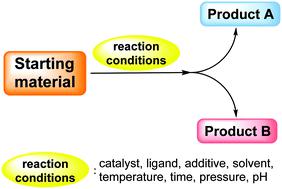当前位置:
X-MOL 学术
›
Chem. Soc. Rev.
›
论文详情
Our official English website, www.x-mol.net, welcomes your
feedback! (Note: you will need to create a separate account there.)
Chemodivergent reactions.
Chemical Society Reviews ( IF 40.4 ) Pub Date : 2020-09-14 , DOI: 10.1039/d0cs00125b Irina P Beletskaya 1 , Carmen Nájera , Miguel Yus
Chemical Society Reviews ( IF 40.4 ) Pub Date : 2020-09-14 , DOI: 10.1039/d0cs00125b Irina P Beletskaya 1 , Carmen Nájera , Miguel Yus
Affiliation

|
An important strategy for the efficient generation of diversity in molecular structures is the utilization of common starting materials in chemodivergent transformations. The most studied solutions for switching the chemoselectivity rely on the catalyst, ligand, additive, solvent, temperature, time, pressure, pH and even small modifications in the substrate. In this review article several processes have been selected such as inter- and intramolecular cyclizations, including carba-, oxa-, thia- and oxazacyclizations promoted mainly by Brønsted or Lewis acids, transition metals and organocatalysts, as well as radical reactions. Catalyst-controlled intra- and intermolecular cyclizations are mainly described to give five- and six-membered rings. Cycloaddition reactions involving (2+2), (3+2), (3+3), (4+1), (4+2), (5+2), (6+2) and (7+2) processes are useful reactions for the synthesis of cyclic systems using organocatalysts, metal catalysts and Lewis acid-controlled processes. Addition reactions mainly of carba- and heteronucleophiles to unsaturated conjugated substrates can give different adducts via metal catalyst-, Lewis acid- and solvent-dependent processes. Carbonylation reactions of amines and phenols are carried out via ligand-controlled transition metal-catalyzed multicomponent processes. Ring-opening reactions starting mainly from cyclopropanols, cyclopropenols and epoxides or aziridines are applied to the synthesis of acyclic versus cyclic products under catalyst-control mainly by Lewis acids. Chemodivergent reduction reactions are performed using dissolving metals, sodium borohydride or hydrogen transfer conditions under solvent control. Oxidation reactions include molecular oxygen under solvent control or using different dioxiranes, as well as chemodivergent palladium catalyzed cross-coupling reactions using boronic acids are applied to aromatic and allenic compounds. Other chemodivergent reactions such as alkylations and allylations under transition metal catalysis, dimerization of acetylenes, bromination of benzylic substrates, and A3-couplings are performed via catalyst- or reaction condition-dependent processes.
中文翻译:

化学趋异反应。
有效产生分子结构多样性的重要策略是在化学发散转化中利用常见的起始原料。切换化学选择性的研究最多的解决方案取决于催化剂,配体,添加剂,溶剂,温度,时间,压力,pH以及甚至底物的微小修饰。在这篇综述文章中,我们选择了几种方法,例如分子间和分子内环化,包括主要由布朗斯台德酸或路易斯酸,过渡金属和有机催化剂促进的氨基苯环,氧杂,硫杂和氧杂氮杂环化,过渡金属和有机催化剂以及自由基反应。主要描述了催化剂控制的分子内和分子间环化反应生成五元环和六元环。涉及(2 + 2),(3 + 2),(3 + 3),(4 + 1),(4 + 2),(5 + 2),(6 + 2)和(7 + 2)工艺是使用有机催化剂,金属催化剂和路易斯酸控制工艺合成环状体系的有用反应。主要是氨基和异源亲核试剂与不饱和共轭底物的加成反应可产生不同的加合物通过金属催化剂,路易斯酸和溶剂依赖性工艺。胺和酚的羰基化反应是通过配体控制的过渡金属催化的多组分过程进行的。开始主要来自cyclopropanols,cyclopropenols和环氧化物或氮丙啶开环反应被施加到无环的合成与在催化剂控制下的环状产物主要是路易斯酸。在溶剂控制下,使用溶解性金属,硼氢化钠或氢转移条件进行化学发散还原反应。氧化反应包括在溶剂控制下或使用不同的二氧杂环乙烷进行的分子氧反应,以及将使用硼酸的化学发散钯催化的交叉偶联反应应用于芳族和烯丙基化合物。其他化学发散反应,例如过渡金属催化下的烷基化和烯丙基化,乙炔的二聚化,苄基底物的溴化和A 3偶联,是通过催化剂或反应条件相关的方法进行的。
更新日期:2020-10-05
中文翻译:

化学趋异反应。
有效产生分子结构多样性的重要策略是在化学发散转化中利用常见的起始原料。切换化学选择性的研究最多的解决方案取决于催化剂,配体,添加剂,溶剂,温度,时间,压力,pH以及甚至底物的微小修饰。在这篇综述文章中,我们选择了几种方法,例如分子间和分子内环化,包括主要由布朗斯台德酸或路易斯酸,过渡金属和有机催化剂促进的氨基苯环,氧杂,硫杂和氧杂氮杂环化,过渡金属和有机催化剂以及自由基反应。主要描述了催化剂控制的分子内和分子间环化反应生成五元环和六元环。涉及(2 + 2),(3 + 2),(3 + 3),(4 + 1),(4 + 2),(5 + 2),(6 + 2)和(7 + 2)工艺是使用有机催化剂,金属催化剂和路易斯酸控制工艺合成环状体系的有用反应。主要是氨基和异源亲核试剂与不饱和共轭底物的加成反应可产生不同的加合物通过金属催化剂,路易斯酸和溶剂依赖性工艺。胺和酚的羰基化反应是通过配体控制的过渡金属催化的多组分过程进行的。开始主要来自cyclopropanols,cyclopropenols和环氧化物或氮丙啶开环反应被施加到无环的合成与在催化剂控制下的环状产物主要是路易斯酸。在溶剂控制下,使用溶解性金属,硼氢化钠或氢转移条件进行化学发散还原反应。氧化反应包括在溶剂控制下或使用不同的二氧杂环乙烷进行的分子氧反应,以及将使用硼酸的化学发散钯催化的交叉偶联反应应用于芳族和烯丙基化合物。其他化学发散反应,例如过渡金属催化下的烷基化和烯丙基化,乙炔的二聚化,苄基底物的溴化和A 3偶联,是通过催化剂或反应条件相关的方法进行的。









































 京公网安备 11010802027423号
京公网安备 11010802027423号